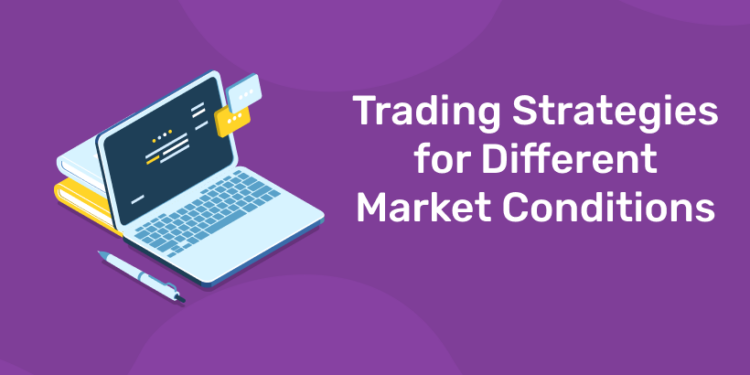Table of Contents
Trading strategies for different market conditions refers to the various approaches that traders use to take advantage of market conditions. In this article, we will discuss trading strategies for different market conditions. The objective of these strategies is to maximize returns while minimizing risk. The specific strategy that a trader uses will depend on the current state of the market. For example, in a bull market, where prices are rising, a trader may employ a long strategy. They will buy securities with the expectation that their price will increase, and then selling them for a profit. Ultimately, the best trading strategy for a given market condition will depend on a variety of factors, including market trends, the trader’s risk tolerance, and their investment goals.
What are Different Types of Trading Strategies?
There are many different types of trading strategies, each with its own unique approach to the markets. Some of the most popular types of trading strategies include:
Learn Stock Marketing with Share Trading Expert! Explore Here!
Trend Following
This strategy involves identifying the current trend in the market and then taking positions that align with that trend. Trend followers capture gains from larger market movements and tend to hold positions for an extended period of time.
Mean Reversion
This strategy involves buying securities that are undervalued relative to their historical averages. It is expected to revert back to their mean eventually. Mean reversion traders look to profit from short-term price movements. They tend to hold positions for a relatively short period of time.
Momentum Trading
This involves buying securities that are showing strong price momentum, with the expectation that their price will continue to rise. Momentum traders look to profit from short-term price movements and hold positions for a relatively short period of time.
Swing Trading
Swing Trading involves taking positions that last anywhere from a few days to a few weeks. The objective is to capture intermediate-term price movements. Swing traders often use technical analysis to identify trading opportunities and make decisions.
Scalping
This strategy involves taking advantage of small price movements and making multiple trades in a short period of time. Scalpers look to profit from small price differences and hold positions for a very short period of time.
Options Trading
Options trading involves using options contracts to either hedge against potential losses or to speculate on the future price movements of a security. Options traders often use complex strategies, such as spreads and straddles, to manage their risk and maximize their returns.
Algorithmic Trading
This strategy involves using computer programs and algorithms to analyze market data and make trades. Algorithmic traders look to take advantage of market inefficiencies and exploit price disparities in a highly automated and systematic manner.
These are just a few of the many different types of trading strategies that are used by traders. The best strategy will depend on a variety of factors, including market conditions, risk tolerance, investment goals, and market knowledge. It’s always advisable to consult a financial advisor before making any investment decisions.
Master stock trading with us. Enroll now for a free demo!
Trading Strategies for Different Market Conditions
The market conditions can be broadly classified into four categories: bull market, bear market, range-bound market, and volatile market. Let’s take a closer look at each of these market conditions and the corresponding strategies that traders can use:
Bull Market
A bull market is characterized by rising prices and a generally optimistic outlook for the economy. In a bull market, traders often employ a long strategy, They buy securities with the expectation that their price will rise and then sell them for a profit. This strategy involves holding on to the securities for an extended period of time and taking advantage of the upward trend in the market.
Bear Market
A bear market is characterized by falling prices and a negative outlook for the economy. Here, traders may employ a short strategy. They sell securities, with the expectation that they will buy them back at a lower price and realize a profit. This strategy involves selling securities in the expectation of downward price movement and buying them back at a lower price.
Range-bound Market
A range-bound market is characterized by prices that move sideways within a certain range. It has limited upward or downward movement. In a range-bound market, traders may employ a range trading strategy. Here they buy at the lower end of the range and sell at the upper end. This strategy involves buying low and selling high within the range. Taking advantage of the limited price movements in the market.
Volatile Market
A volatile market is characterized by rapidly fluctuating prices and high levels of uncertainty. In a volatile market, traders may employ a volatility trading strategy. Here they take advantage of rapid price movements to buy low and sell high. This strategy involves using stop-loss orders to minimize risk and taking advantage of the rapid price fluctuations to realize profits.
Conclusion
It’s important to note that no trading strategy is foolproof and all come with risks. Traders should also keep in mind their risk tolerance, investment goals, and market knowledge before choosing a strategy. It’s always advisable to consult a financial advisor before making any investment decisions.
Start investing like a pro. Enroll in our Stock Market course!
Trading strategies for different market conditions. FAQs?
1. How do I determine which market condition we are in?
Ans. There are several indicators that traders use to determine which market condition they are in. They include the performance of the overall market, economic indicators, and technical analysis. Some traders also use a combination of different indicators to make this determination.
2. Can I use the same trading strategy for all market conditions?
Ans. It’s not recommended to use the same trading strategy for all market conditions, as different market conditions require different approaches. For example, in a bull market, a long strategy may be appropriate. Where as in a bear market, a short strategy may be more appropriate.
3. How do I manage risk when using a trading strategy for a specific market condition?
Ans. Risk management is an important aspect of any trading strategy, regardless of the market conditions. Traders can use a variety of tools and techniques, such as stop-loss orders, to manage risk. It’s also important to have a well-defined risk management plan in place before entering any trades.
4. How often should I adjust my trading strategy based on market conditions?
Ans. The frequency with which a trader should adjust their trading strategy will depend on several factors. This includes the volatility of the market and the trader’s investment goals. Some traders may adjust their strategies frequently. Where as the others may only make changes when they see a significant change in market conditions.
5. Can I use a combination of different trading strategies for different market conditions?
Ans. Yes, traders can use a combination of different trading strategies for different market conditions. For example, they may use trend following strategy for a bull market and mean reversion strategy for a bear market. The key is to have a well-defined plan and to understand the risks and benefits of each strategy.
Start investing like a pro. Enroll in our Stock Market course!











